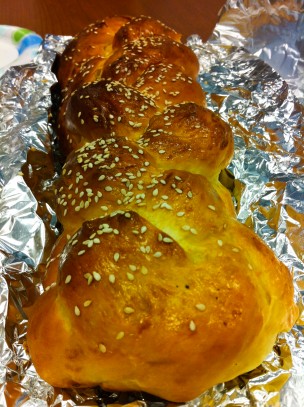
Andrew Ribner/Visual Editor
I’m really bad at baking. Really, I do it all wrong. For someone who baked five times per week on average this summer, I really am the worst at following directions. If you happen to like something I make, never ask me for a recipe, because it probably won’t exist.
Many say that baking is a science; a very certain amount of “this” must react with a specific amount of “that” in order to make the perfect “those.” Personally, I think baking is more of an art. Enough of an ingredient is added until the baker decides either the feeling or the consistency is ideal. If something doesn’t seem right by the artist’s standards, it’s his or her prerogative to change it.
A recipe is more like a set of guidelines anyway, I always say.
Bread making, however, is a particularly precise and unforgiving art form that demands more time and greater patience than most baked treats. The temperature of the water, the timing and number of rises, and the quality of ingredients speaks more in the final product than in other goodies. Above all, bread baking takes commitment. I tend to use it as a semi-productive procrastination tool. By pre-determining times at which I have to be home to actively do things to the dough, I force myself to be productive between rises.
All that said, I still like to find myself the most forgiving breads, that allow me to use my artistic license and make rising times more flexible. Thus: challah. Tasty at any time of day or year, challah is always a crowd-pleaser and is hugely satisfying to make. There are typically three rises, which total about two-and-a-half hours, but any or all of them can be prolonged as needed. While people associate challah with Friday nights and Shabbat, I feel no need to ascribe to a norm that determines when I should and should not eat my bread—although challah made on Friday does make great French toast on Sunday. Just one more reason to make this delicious braided bread.
Ingredients
Dough:
3/4 package active dry yeast (3/4 tablespoons)
1/2 cup honey plus 2 tablespoons honey
1/2 cup olive or vegetable oil, plus more for greasing the bowl
2 large eggs
2 teaspoons table salt
4 1/2 to 5 cups all-purpose flour
Egg Wash:
1 large egg
Poppy or sesame seeds for sprinkling
In a large bowl, dissolve yeast and two teaspoons honey in about one cup warm water. Enjoy the smell of yeast while it proofs (or rests and ferments) for 5-10 minutes, until foamy.
Whisk oil into yeast, then beat in two eggs with remaining honey and salt. Gradually add flour. I stress gradually, unless you want your kitchen covered in flour as mine has been several times. When dough holds together, it is ready for kneading. (If you happen to be lucky enough to have a stand mixer with a dough hook, you can also use it for both mixing and kneading.)
Knead on a floured surface until smooth—add flour as needed. Grease bowl well and return dough to bowl. Cover with plastic wrap, and let rise in a warm place for one to one-and-a-half hours, until almost doubled in size. Dough may also rise in an oven that has been warmed to 150 degrees then turned off. You may alternatively carry your bowl of dough around campus, as I am wont to do. Punch down dough, cover, and let rise again in a warm place for another half-hour.
If you want to include any optional ingredients (raisins, apples, jam, etc.), this is the time to fold them in. Make sure they are cut to bite-sized portions.
At this point, you have two important decisions to make: how many braids, and how many challahs? I tend to do four-strand braids—you can definitely do three braids, like a traditional hair braid, but what’s fun about that? I also tend to make two small challahs, because quantity is better than quality. Roll the dough into four balls (or eight, if making two), and with your hands, roll each ball into a strand about 12 inches long and 1 1/2 inches wide.
The fun part: braiding. Place the strands in a row, parallel to one another. Pinch the tops of the strands together. Move the outside right strand over two strands, then place the second strand from the right over the strand you just moved (the new third strand). Then take the far left strand and move it two to the right. Again flip the two middle strands. Continue this pattern until the end of the challah. Place braided loaves on a greased cookie sheet with at least two inches in between.
Beat remaining egg and brush it on loaves. Let rise another hour.
About 45 minutes into the rise, preheat oven to 375 degrees and brush loaves again. Sprinkle bread with seeds, if using.
Bake in middle of oven for 20-30 minutes, or until golden. (If you have an instant-read thermometer, you can take it out when it hits an internal temperature of 190 degrees.)
The most difficult step: try not to eat the entire loaf before it cools.